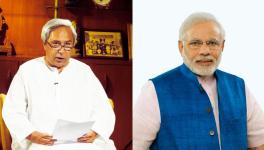China Syndrome and Spectre of Cold War 2.0

Pangong Tso lake. Image used for representational purposes only. | Image Courtesy: Needpix.com
An uncanny peace prevails on India’s China border. The Indian government first falsely assured everyone that no Indian territory had been lost to China. More recently, it has conceded that the border situation is tense, and that India is prepared to retaliate militarily if the situation so demands. Against the background of all kinds of contradictory statements over the months, this clarity is welcome. But since the state—any state—is a congenital liar, one does not know what is actually in store and to what extent people are being taken for a ride.
September 15 marked the second instance since the abrogation of Article 370 in Kashmir (August 2019) that the Indian government has categorically referred to the illegal Chinese occupation of 1,33,180 sq km of Indian territory, including Aksai Chin, portions of POK, and vast stretches of Arunachal Pradesh. Several meanings can be adduced from the statement.
One, India is preparing for an all-out war with China to regain its lost territories. It may be honey to the ears of our self-styled nationalists, but given the power differential between the two nations, it would likely be a case of “fools rush in where angels fear to tread”. This is, therefore, ruled out, though India’s message is loud and clear: “[T]he situation this year is very different both in terms of scale of troops involved and the number of friction points, we do remain committed to the peaceful resolution of the current situation. At the same time, the House [Lower House of Parliament] can be assured that we remain prepared to deal with any contingencies.”
Two, the statement is meant to play to the gallery. Anyone who has analysed Narendra Modi’s blitzkrieg-style diplomacy carefully must have noticed that it is heavily loaded in favour of catering to the domestic audience. Even his meetings with NRIs in developed countries were primarily meant to communicate with their families and friends back home in India. At present, Modi is the uncrowned king of India. All that his devotees want to hear from him is that everything is hunky-dory and when it comes to the crunch, he would teach China a veritable lesson. After all, who does not like a feel-good atmosphere? Modi knows how to mollycoddle this “all is well” mentality.
Three, more than India, it serves China’s interests. Diplomatic parleys with the Chinese to diffuse the situation and reclaim almost 1,000 sq km of Indian territory have been ongoing for several weeks now. Nowhere has one come across any Chinese commitment, either in the joint statement, or in the two separate statements released to mark the conclusion of the India-China meeting of Foreign Ministers, between S Jaishankar and Wang Yi on 10 September. Nor was there any reference nor any demand from the Indian side that China must restore the status quo ante as in April.
Four, by referring to the loss of more than a 100,000 sq km of Indian territory in the sixties, and not the 1,000 sq km in the last few months, the Modi government has reverted to a well-worn strategy: blame Pandit Jawaharlal Nehru. Politically, this rhetoric served BJP well in its ascension to power, and there is no reason to think that it cannot continue to pay dividends. Who cares to ponder that this huge territorial loss was also staring at Modi in the face when he was indulging with so much aplomb in his personalised diplomacy with Xi Jinping? Evidently, this territorial loss did not come in the way of the Wuhan Spirit or the Mamallapuram Summit.
Five, and most important, now that the much-hyped bonhomie between India and China has so terribly soured, what should India’s larger diplomatic game-plan be? Ever since United States President Donald Trump’s rise to power, Modi has wholeheartedly stood by the former’s side, conscious of the fact that not only do the Indian-Americans matter in American politics, but that they also constitute a huge source of support for the BJP through their financial and cultural connections to India. As the COVID-19 pandemic has devastated his presidency, Trump has increasingly resorted to playing the anti-China card to retain his electoral base. Is Modi preparing to play ball with Trump?
Against this background, it is not surprising that Trump would try to rope India into the snare of “Cold War 2.0”, the prospect of which he has aggressively encouraged. Simply put, the idea connotes that just like the world was divided between American and Soviet camps during the original Cold War, the second iteration will be a war of nerves between those who side with America and those who side with China. The slogan is certainly not without attractions, particularly at the present juncture of India’s discomfiture with the Chinese. But should India take the bait? Whether the idea survives the United States presidential election or not is another matter, but it will certainly not be easy for a subordinate power like India to adjust to the ever-changing requirements of a superpower like America. Caveat emptor!
India must, therefore, swallow this Cold War 2.0 recipe with a pinch of salt. We would do well to remember that from the end of the Cold War until 9/11, when Islamic terror became the focal point of United States global strategy, it was Japan that occupied the role of America’s prime adversary. Debates in American academia during those years centred on the impending economic tussle between America, Japan and Western Europe. There was increasingly strident talk of a “car war”, with fears that American marques would be overrun by Japanese ones. Tough trade negotiations eventually forced Japan to budge and accept a quota for exports to America, leading Noam Chomsky to jibe that ultimately it was not trade but aid that salvaged the American economy! China was nowhere in the reckoning then.
Like the United States-Japan car war, what we see between America and China today is a technology war. Who will beat whom in the realm of Artificial Intelligence is the question. In this 21st century great game, India will matter marginally. Some in India may still hope that when the chips are down, the United States will come to India’s aid. But that is not how superpowers behave. They see to their interests first (and last). Notice that in the many instances that President Trump has offered to mediate between India and Pakistan on Kashmir or between India and China in their border row, not once has he taken a clear pro-India position.
One last point. In the ultimate analysis, a nation will have to fend for itself. Foreign tie-ups help but they are no substitutes for national strength. After all, foreign policy does not float in a vacuum. And what matters most for national security are internal stability and strength. At present, India suffers from many fault lines. Indian society was never as polarised as it is now. The Indian economy was never worse off than it is now. Indians were never as poorly informed as they are now. Even such a major event like the Chinese intrusion into our territory was obfuscated for three months by contradictory statements emanating from the highest levels. Let it be said without mincing any words: honest questioning of the government is the best form of nationalism. By that token, there is an alarming dearth of nationalism in India today.
Postscript: International politics is one of the most discussed subjects in middle class living rooms, yet it is also one of the least understood. Sometimes, even serving diplomats have no idea what their political masters are up to. Henry Kissinger’s secret trip from Islamabad to China in 1971, which was meant to pave the way for the Nixon-Mao Summit the following year, was not known even to senior officials of the American embassy in Islamabad. The lone exception was the United States ambassador, Joseph Farland.
For everyone else in the embassy, as well as in the international press, Kissinger was recuperating in the Nathia Gali hill resort in Abbottabad, a three-hour drive from Islamabad. He had supposedly been advised by the doctor to rest his “Delhi Belly”, a parting gift from his just-concluded India trip. Another real-life story from the Cold War days comically underscores the point. At the height of United States-Soviet tensions in the early 1950s, it was written on the wall of the men’s room at UNHQ: “This is the only place where you know what you are doing.”
The author is a senior fellow at the Institute of Social Sciences, New Delhi. He is a former ICSSR National Fellow and professor of South Asian Studies at JNU. The views are personal.
Get the latest reports & analysis with people's perspective on Protests, movements & deep analytical videos, discussions of the current affairs in your Telegram app. Subscribe to NewsClick's Telegram channel & get Real-Time updates on stories, as they get published on our website.
























